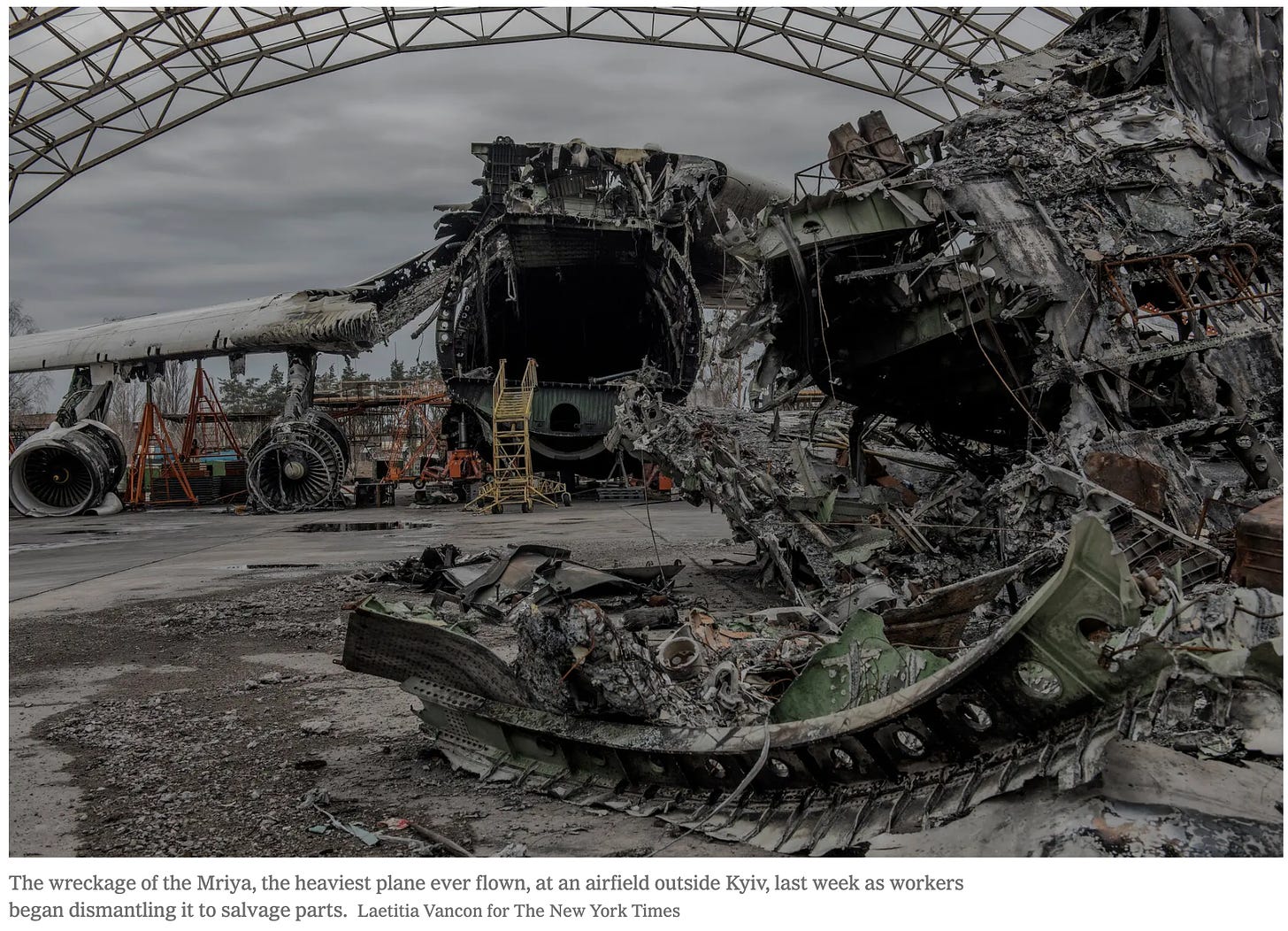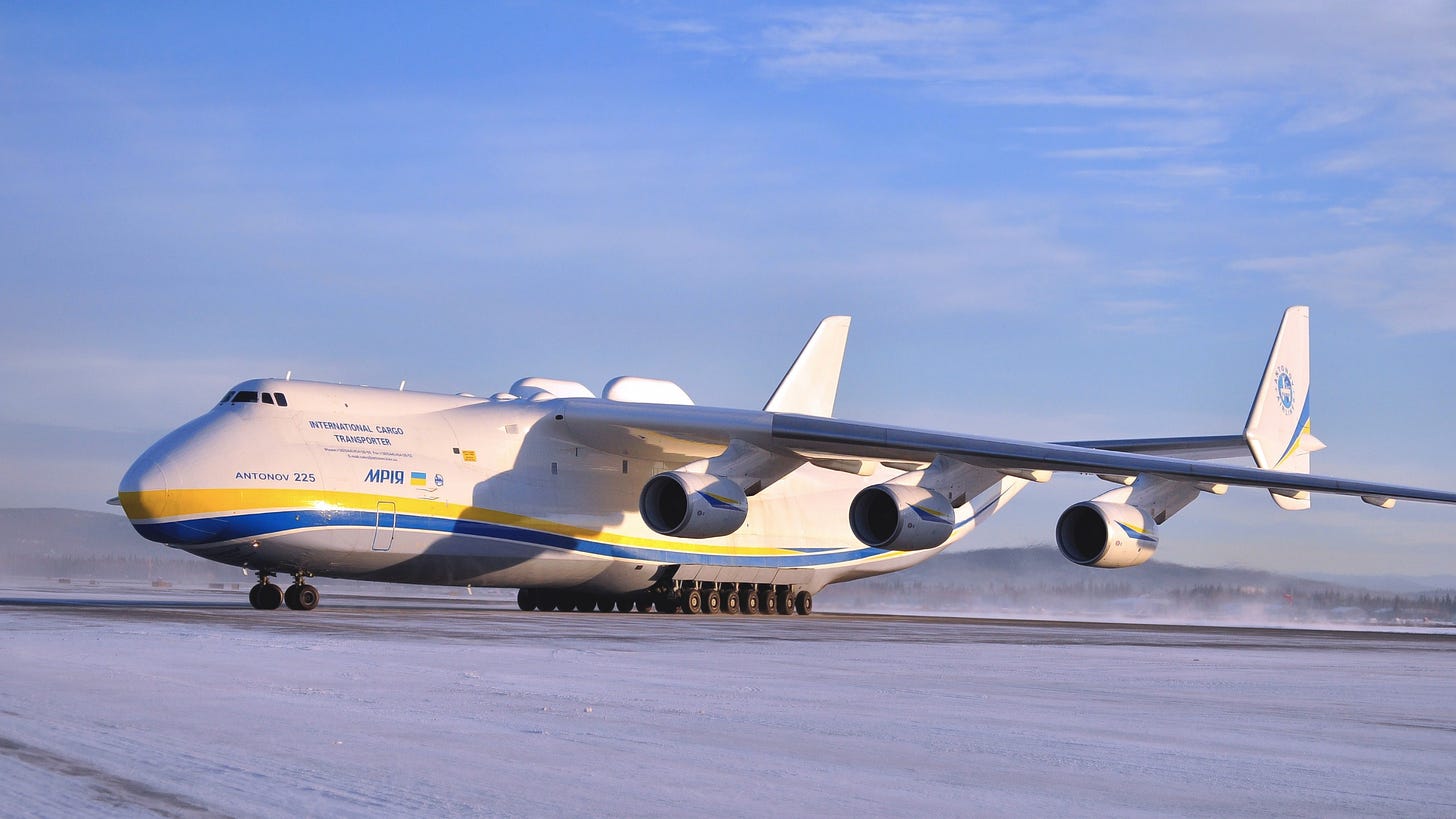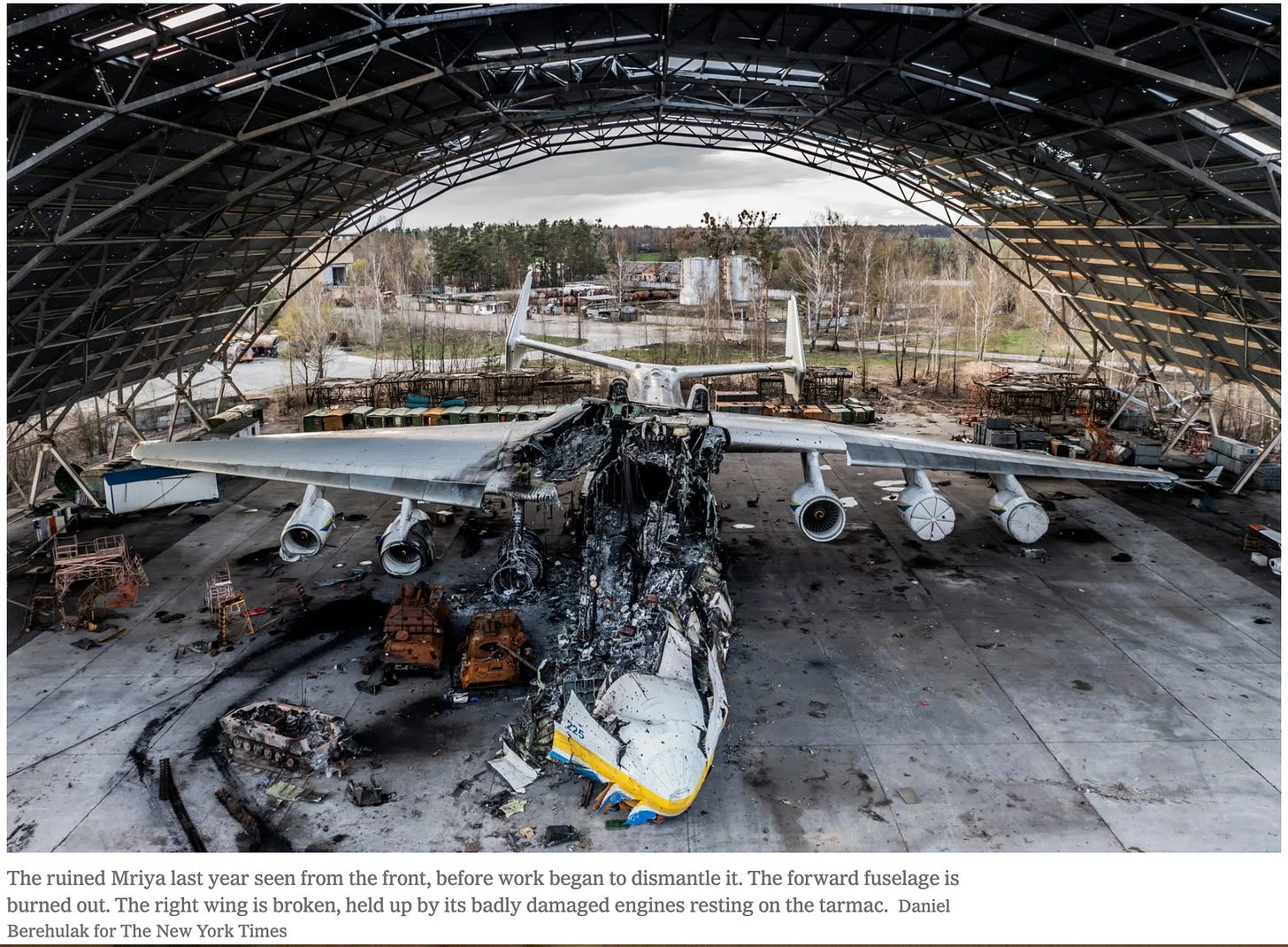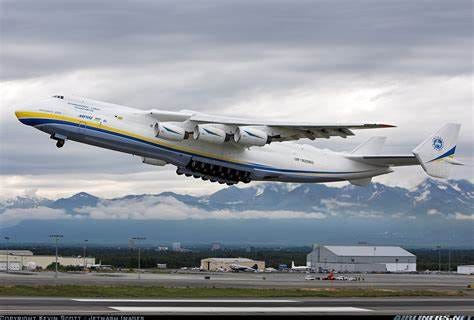(This is dedicated to my late friend and aviation geek extraordinaire, Tim Smith, who left us far too soon. You were the best, Tim. Every time I catch a flight at PDX, I think of you. I miss you.)
Once upon a time, I worked at the information center at Portland International Airport. During the roughly two years I worked there, I learned a great deal about the inner workings of an airport, which I found surprisingly fascinating. It was interesting work, and I was fortunate to work with some fascinating people.
One of the things I was fortunate enough to see on a few occasions was something I’ll never forget for its sheer oddity and immensity. It was an aircraft so large, so seemingly unwieldy and lacking in airworthiness that there was no way it could get off the ground. And yet….
HOSTOMEL, Ukraine — The gigantic twin tail fins, once stretching as high as a six-story building, are gone.
So are the tailplane, flaps, hydraulic systems, fuel pumps and three of six engines of the plane, which was destroyed in fighting in the first days of the war.
Piece by piece, workers are now dismantling the wreckage of the gigantic Mriya cargo plane, the heaviest airplane ever flown, with plans to build a new one with salvaged parts. The restoration of the plane, whose name in Ukrainian means The Dream, has begun.
It was massive and dwarfed anything it was parked next to, including a Boeing 747. To look at it was to question how it could possibly get up enough speed to lift off a runway, and the one time I was fortunate enough to watch Mriya take off, it defied my limited understanding of physics.
Looking at Mriya parked on a runway, it was easy to think of Howard Hughe’s Spruce Goose, now housed in a museum in McMinnville, OR, about 40 miles southwest of Portland. The Spruce Goose was unwieldy and barely airworthy, but Mriya has taken her bulk around the world as a cargo transporter.
It turns out that the world’s largest aircraft, the pride of Ukraine, was a workhorse.
I speak of Mriya in the past tense because when Russia attacked Ukraine in February 2022, Russian special forces landed at Hostomel airport outside Kyiv, where Mriya was based.
The evening before Russia invaded, a crew had the plane prepared to fly to safety outside Ukraine, Maksym Sanotskyi, the company’s deputy director for transport, said in an interview. Takeoff was scheduled for the following afternoon. But time ran out.
Russian troops crossed the border in the pre-dawn and Russian special forces swooped into the Hostomel airport, the base for the Mriya, with a helicopter assault. In the ensuing battles over the airport, located just outside Kyiv, the plane was sprayed with shrapnel and caught fire.
Last week, alongside the company’s announcement of progress on restoring the craft, police announced the arrest of several former executives of the Antonov company on suspicion of obstructing the work of the military in securing the Hostomel airport in the days before the invasion.
In a statement, prosecutors said the company had not allowed the Ukrainian National Guard to build defensive positions at the airport, for reasons that remain unclear, leading to the destruction of the Mriya. Mr. Vlasyk, the deputy director, said he could not comment on the investigation.
Mriya, though it was the pride of Ukraine, was the only one of its kind. It was designed to be a workhorse for the Soviet space program, which needed a workhorse to transport the equipment necessary for the Soviet space shuttle program.
It also served a propaganda purpose, showing that the USSR could still do big things and compete with the West when it came to engineering and building mighty vehicles on land and in the air.
The plane, built in Kyiv in the 1980s and extensively overhauled after the country won independence from the Soviet Union, has long been Ukraine’s pride. Designated AN-225, it was bigger than any other in the sky, with a wingspan of 290 feet and a maximum takeoff weight of a staggering 1.4 million pounds.
It was made to carry the Buran, the orbiter in the short-lived Soviet space shuttle program. Later, its bulbous, almost cartoonishly rotund body carried unwieldy industrial objects like wind turbine blades or locomotives, and pleased crowds at air shows.
The destruction of Mriya was a significant blow to Ukraine, which had always been proud that the plane had been built in Ukraine. Because Mriya is a one-off, many of her parts are custom-built.
Engineers are now trying to salvage what they can from the wreckage so that when the time comes to rebuild Mriya, they’ll have something to start with.
Workers are unbolting what they can from the soot-smeared wreckage and engineers are drafting plans to use these rescued parts, along with spare parts, engines from a similar aircraft and a long-mothballed extra fuselage — to build a new airplane, company executive say. The project is expected to cost about $500 million, and financing has yet to be lined up.
But the company said the lengthy lead time to get the plane in the air again means it cannot wait to begin planning and collecting parts. Antonov said it is in talks with European, American and Asian aviation companies, and with potential customers for future cargo flights.
Of course, in Ukraine, where so many towns and villages have been utterly destroyed, rebuilding Mriya can’t be a priority. Antonov, the company that owns her, knows this. But the symbolism of the plane can’t be ignored, so rebuilding Mriya will be a substantial morale boost for Ukraine.
Regardless of when the war ends, it will be many years before the country returns to what it was before. It will probably require something like the post-WWII Marshall Plan to put Ukraine back together again. Rebuilding Mriya may be part of that plan, if only from a symbolic standpoint.
After 14 months of brutal war, hardly a city or village in Ukraine has been left untouched by missile strikes, occupation, or some aspect of the war that has left damage in its wake. For a country that had just begun to enjoy its emergence as a democracy (though it was still infamously corrupt) and looking hopefully to the West, the war came at just about the worst possible time. Its economy was growing, but not nearly enough to begin to cover the damages done to the country throughout the war.
Millions of Ukrainians are displaced, some within the country, but many throughout Europe and others dispersed throughout other Western countries. Beyond the economic costs of rebuilding Ukraine, the emotional costs of repopulating the country will be staggering. It may take generations before Ukraine returns to anything close to what it was before the war.
In light of this, restoring Mriya seems relatively insignificant, and in many ways, it is. Nonetheless, she retains significant symbolic value to Ukrainians. That such a massive plane was built by a relatively small country is an understandable source of pride.
Antonov says the airplane has commercial potential — when it is chartered by companies in the energy industry, for example, to haul huge pieces of equipment around the world, the hourly cost is about $32,000. The company also said the plane is priceless as a symbol of Ukraine.
But a former engineer at Antonov, Anatoly Vovnyanko, has told Ukrainian media he doesn’t believe the company will ever recoup its outlays through commercial charters. “No one needs it, this Mriya,” Mr. Vovnyanko said. “The money will never be recovered.”
Even the plane’s main appeal, its gigantism, has drawn criticism as a holdover of Soviet mentality that Ukraine has no need for today.
The Soviets built “the world’s largest locomotive, bulldozer, sugar factory, iron smelter” and so on, one critic, Serhiy Marchenko, wrote on Facebook. “All these greatest things have one thing in common: senselessness.”
He called the public relations efforts around the restoration an affront to people who lost their homes in the war.
Marchenko’s correct, of course. The Soviet Union specialized in senselessness. They couldn’t compete with the West on quality or efficiency, but they could hold their own when it came to size and senselessness of scale. And so they managed to devise some genuinely massive contraptions that are now museum pieces or have long since been dismantled for scrap.
Antonov doesn’t need Mriya. They have smaller cargo transports they can use that operate more efficiently. But none of them have the priceless symbolic value to Ukraine that Mriya does.
Marchenko’s also correct in his assertion that the PR effort around the effort to restore Mriya is an affront to those who’ve lost their homes and more during the war. There are so many more pressing priorities. Some entire towns and cities must be rebuilt, restored, and repopulated. Somehow, Ukraine’s economy must be pieced back together. Despite the war, the country remains the world’s breadbasket.
Many challenges remain. While the Mriya shares parts in common with another, Ukrainian-made cargo plane, the Ruslan, some parts will have to be custom made. Half a dozen Ruslan planes are still flying from a base in Germany.
On the positive side, the company has a complete fuselage for a Mriya plane in storage, left over from an abandoned plan to build a second cargo giant. Salvaged and new parts can be fitted to this fuselage.
So far, three of six jet engines, flaps, parts of the hydraulic systems, some of the landing gear and fuel pumps and the tail assembly have been salvaged, said Mr. Sanotskyi. Certifying the new plane as airworthy with European and American regulators will be a challenge, he conceded.
Valentyn Kostiyanov, 68, a technician who worked on the Mriya when it was built in the 1980s, was examining the tangles of wires and hydraulic lines deep inside the wreckage one day last week, searching for possibly flight-worthy parts….
The plane, now propped up on jacks, creaks in the wind and strips of insulation flutter from holes in the fuselage. Wires dangle from the wings. “So much time we put into it, thousands of hours, for years we were building it,” Mr. Kostiyanov said, only to see it destroyed in the Russian invasion.
He has no second thoughts about the decision to try to make the plane fit for flying again.
“Ask anyone in Ukraine,” he said. Even a “two-year-old child will tell you to rebuild the Mriya.”
I can still remember looking at Mriya from the observation deck at PDX as I tried to imagine how something so impossibly ungainly could get airborne. And yet when I watched it take off, it did so gracefully and without noticeable difficulty.
I’m not an aviator, so I can begin to understand or explain how Mriya could get airborne, but I witnessed it, so I know it’s possible. Still, to look at her on the ground is to see something that looks like it should be a rolling hotel, not the world’s largest cargo plane.
I remember admiring Mriya with one of PDX’s operations workers, the late Tim Smith. Tim had forgotten more about aircraft than most people will ever know, and what he knew about Mriya was fascinating. I never understood why Mriya was at PDX or how the runways could be long enough to accommodate her, but somehow it all worked. Whenever Mriya was on the tarmac at PDX, Tim was always careful to mention that Antonov was security conscious to the point of being paranoid. They didn’t want airport employees talking about Mriya being on-site, and they didn’t want pictures taken.
Like anyone could resist taking pictures of something so massive and impossibly unique.
I’ll be interested to see if and/or when Mriya is finally rebuilt. But, of course, given what Ukraine is facing when the war ends- and who knows when that will be- putting the world’s largest cargo plane back together can’t be a high priority. Still, it will be a symbolic victory when she finally rolls down the runway at Hostomel and lifts off skyward again.









Thanks -- I had no idea!